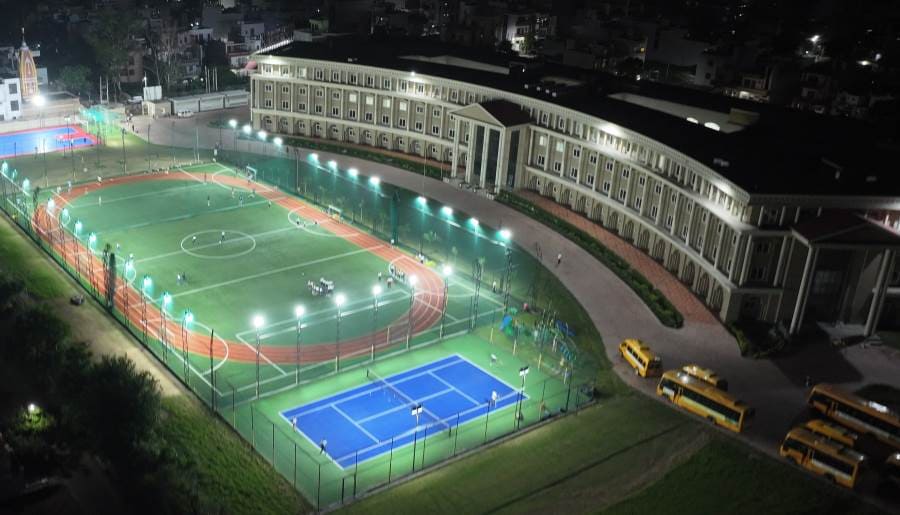India’s goal to host the 2036 Olympics is a confident move with a long-term perspective. This marks a turning point in our country’s character, sporting excellence can now coexist with the economic and technological prowess we have achieved.
The sight of the tricolour in global competition, our record-setting athletes, and a more consistent tally of medals is a sign that India is no longer to be considered an outsider in global sport. It leaves one question unanswered: have we constructed the necessary grassroots infrastructure to make this possible?
For each Neeraj Chopra or Mirabai Chanu standing on the podium, thousands of equally qualified children go unnoticed not due to a lack of skill but due to a shortage of opportunities – a playground, a coach, a safe place to run. These are no luxuries but the fundamental elements upon which champions are formed.
Yet, the Comptroller and Auditor General (CAG) found that approximately 40% of government schools have lack usable playground. Even in cities, playgrounds are either under encroachment or are badly looked after. Without these “building blocks” of sports infrastructure, India’s Olympic dream will be nothing more than an elite aspiration.
The Need of the Hour
The path to an Olympic podium frequently begins in early childhood, developed over the course of many years of regular play and exposure to different sports. India’s sporting sector lacks a cultural emphasis on this early-stage involvement. While high-performance domains and academies have made significant contributions, they cater to only a portion of the demographic. The journey must start wherever children first happen to play- schools, community fields, and local parks.
In Olympics, country’s population does not matter, neither does the size of its territory. Countries like Cuba, Netherlands, Kenya and the like outstrip India in this department as they are more synched to sports and have ingrained it in their cultures! They fund local infrastructure, value physical education, and consider sports not a sideline activity but means to national glory and social progress.
Regions Showing Promise
Some Indian states are waking up to the potential of bottom-up infrastructure. Rural sports facilities in Haryana and training camps have also ensured a steady supply of Olympic wrestlers and athletes. Hockey Odisha, with a backing from the state government which partnered with Hockey India and built the Kalinga Stadium, made the state the new hub of national hockey. And also in the same way, Manipur, for all its relative impoverishment, has thrown up global icons like Mirabai Chanu and Mary Kom thanks to its community-based sporting culture.
Cities such as Bhubaneswar, Pune and Ahmedabad are at the forefront of developing upgraded public sports facilities with professional academies and grassroots programme. Still, they are more the exception than the rule. To truly make an Olympic nation out of India, these efforts have to be multiplied wherever the raw talent is lying untapped – and that’s in tier-2 and tier-3 cities.
The Role of Corporations and Educational Institutions
Corporations have a critical role to play in bridging the infrastructure gap. While CSR investments have changed the landscape of education, healthcare, sanitation; sports still remain grossly underfunded. Yet, sports development is a recognized CSR activity under Schedule VII of the Companies Act. A small percentage of existing CSR budgets redirected towards playgrounds, multi-sport complexes, and coaching programs could revolutionize grassroots sports.
Educational institutions, private and especially government schools, must also step up. Physical education should be treated with the same seriousness as academics, and taken as serious as other subjects. State and national school boards can collaborate with private companies to build multiuse facilities, where sports are built into the daily life of the child. Public-private partnerships could be the game-changer in democratizing sports infrastructure.
Creating a sports culture is not about one-time mega events but small, every day acts: Funding a playground at a school, opening a local park, or providing a trained coach. Each playground we build is an investment in our youth, and faith in their future.
City leaders should not treat the 2036 Games as a finish line, but rather as the start of a longer journey. To reach that point, India must invest in its grassroots sport infrastructure with the same urgency that it invests in highways or smart cities. Because playgrounds build more than athletes – they build confidence, discipline, and healthier societies.
If we really want India to be viewed as a real sports nation, “the real question isn’t just how many medals we win today, it’s how many playgrounds we build today to win medals tomorrow”.
Views of the author are personal and do not necessarily represent the website’s views.
 Author of the above article Mr. Nasir Ali is the Founder & CEO of Gallant Sports & Infra, a leading sports infrastructure company. He also founded Gallant Play, a post-pandemic initiative aimed to inspiring 1 million health-conscious individuals of all generations to embrace active living through sports, operating multi-sports arenas across Delhi NCR to make fitness more accessible. With over 24 years of experience across industries like fashion, agriculture, and medical equipment, Nasir transitioned into sports infrastructure during the 2010 Commonwealth.
Author of the above article Mr. Nasir Ali is the Founder & CEO of Gallant Sports & Infra, a leading sports infrastructure company. He also founded Gallant Play, a post-pandemic initiative aimed to inspiring 1 million health-conscious individuals of all generations to embrace active living through sports, operating multi-sports arenas across Delhi NCR to make fitness more accessible. With over 24 years of experience across industries like fashion, agriculture, and medical equipment, Nasir transitioned into sports infrastructure during the 2010 Commonwealth.


